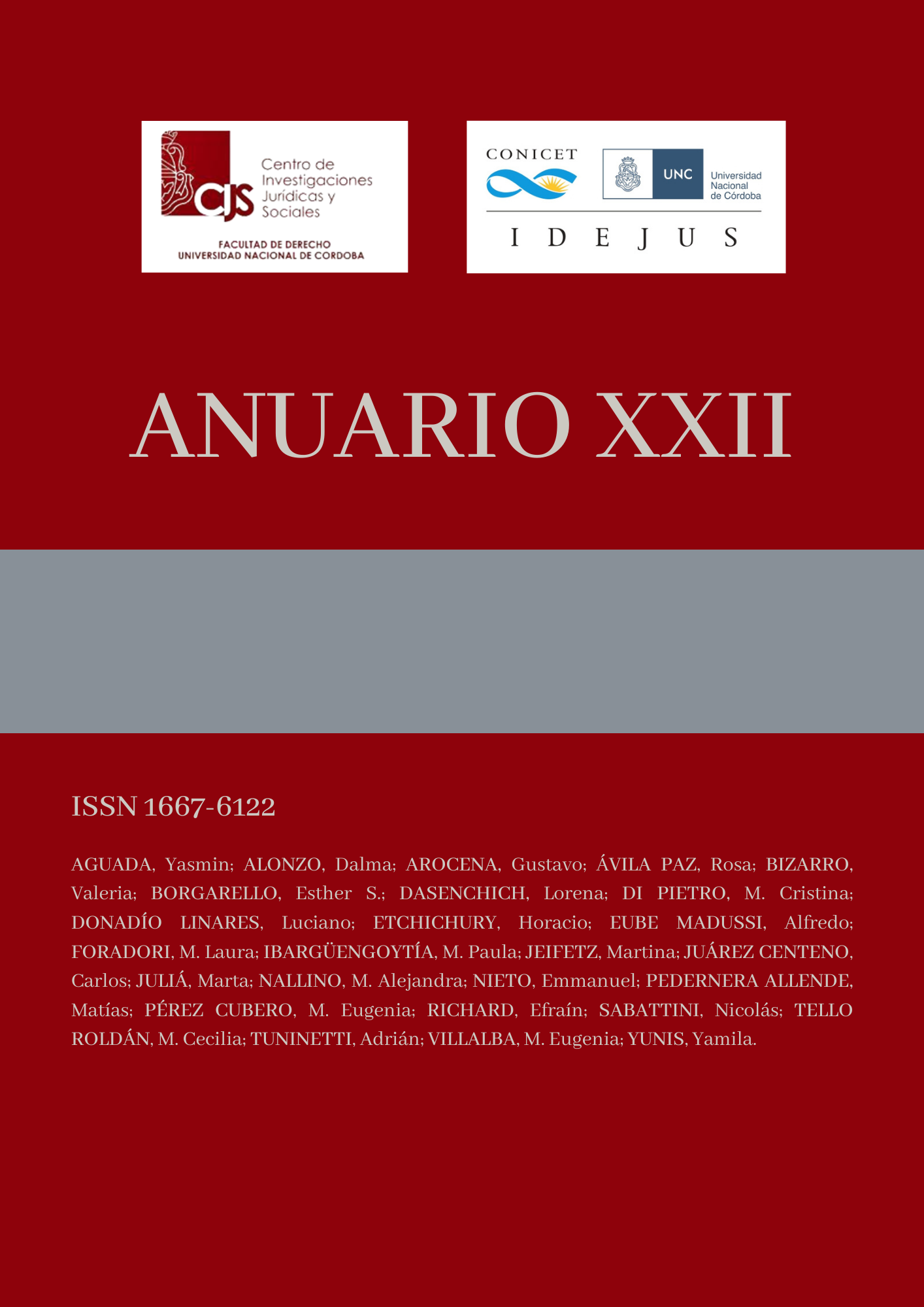EXPLORANDO EL PODER POTENCIAL DEL PRINCIPIO CBDR PARA LA CONSERVACIÓN DE LA DIVERSIDAD BIOLÓGICA. LOS EFECTOS JURÍDICOS DE LA DEFINICIÓN DE LA LÍNEA DE BASE
Palabras clave:
Biodiversidad, Líneas de Base, Marco Mundial Kunming, Montreal para la Biodiversidad, Responsabilidad Internacional, Responsabilidades Comunes, pero Diferenciadas (CBDR)Resumen
El Marco Mundial para la Biodiversidad debió determinar qué línea de base se utilizaría para medir la implementación del Convenio sobre la Diversidad Biológica, lo que no sólo influiría en algunas cuestiones técnicas, sino también en la dimensión jurídico-política referida al alcance y aplicación del principio de responsabilidades comunes, pero diferenciadas (CBDR), en el Convenio. Debido a la persistente divergencia entre las Partes y el consecuente vació legal, este artículo explora si el principio se funda en la solidaridad internacional o si expresa un componente de responsabilidad que justifica la reparación del daño ambiental histórico y sus efectos acumulados hasta el presente.
Referencias
ALAM, Shawkat, “Trade and the Environment: Perspectives from the Global South” en ALAM, Shawkat, ATAPATTU, Sumudu, GONZÁLEZ, Carmen, et al. (editors), International Environmental Law and the Global South, Cambridge University Press, Cambridge, 2015, pp. 297-316.
ATAPATTU, Sumudu, “The significance of the International Environmental Law Principles in Reinforcing or Dismantling the North-South Divide”, en ALAM, Shawkat, ATAPATTU, Sumudu, GONZÁLEZ, Carmen, et al. (editors), International Environmental Law and the Global South, Cambridge University Press, Cambridge, 2015, pp. 74-108.
BIRNIE, Patricia, BOYLE Alan, REDGWELL, Catherine, International Law & the Environment, Oxford University Press, New York, 2009, 3rd. Edition.
CULLET, Philippe. “Common but Differentiated Responsibilities”, en VIÑUALES, JORGE E., The Rio Declaration on Environment and Development, Oxford University Press, Oxford, 2015, pp. 229-244.
DELLINK, Rob, ELZEN, Michel, AIKING, Harry et al., “Sharing the burden of financing adaptation to climate change” Global Environmental Change, 2009, 19, pp. 411–421.
DONADIO LINARES, Luciano M., “The awkward question: What baseline should be used to measure biodiversity loss? The role of history, biology and politics in setting up an objective and fair baseline for the international biodiversity regime”, Environmental Science & Policy, 2022, 135, pp. 137-146.
DUPUY, Pierre-Marie, VIÑUALES, Jorge E., International Environmental Law, Cambridge University Press, Cambridge, 2018, 2nd Edition.
Grupo Intergubernamental de Expertos sobre el Cambio Climático (IPCC), Fifth Assessment Report of the Intergovernmental Panel on Climate Change [Core Writing Team, PACHAURI, RAJENDRA K. Y MEYER, LEO (eds.)]. IPCC, Geneva, 2014.
GUPTA, Joyeeta, SÁNCHEZ, Natalia, “Elaborating the common but differentiated responsabilities in the WTO”, en CONDONIER SEGGER, Marie-Claire Y WEERAMANTY, Christopher. Sustainable Development Principles in the Decisions of International Courts and Tribunals (1992-2012), Routledge, New York, 2017.
HALVORSSEN, Anita Margrethe. Equality Among Unequals in International Environmental Law. Differential Treatment for Developing Countries, Routledge, New York 1999.
HONKONEN Tuula. The Common but Differentiated Responsibility Principle in Multilateral Environmental Agreements: Regulatory and policy Aspects, Kluwer Law International, The Hague, 2009.
International Law Association (ILA), New Delhi Declaration of Principles of International Law Related to Sustainable Development, UN Doc. A/CONF.199/8 (9 de agosto de 2002). Resolution 3/2002, Principle 3(2).
IPBES, The IPBES assessment report on land degradation and restoration, MONTANARELLA, Luca, SCHOLES, Robert Y BRAINICH, Anastasia. (eds.). Secretariat of the Intergovernmental Science-Policy Platform on Biodiversity and Ecosystem Services, 2018, Bonn.
IPBES, Global Assessment Report on Biodiversity and Ecosystem Services of the Intergovernmental Science-Policy Platform on Biodiversity and Ecosystem Services. DÍAZ, Sandra, SETTELE, Josef, BRONDÍZIO, Eduardo, et al. (editores). IPBES Secretariat, Bonn, 2019.
JACHOWSKI, David S., KESLER, Dylan C., STEEN, David A. et al. “Redefining Baselines in Endangered Species Recovery” Journal of Wildlife Management, 2015, 79, (1), 3-9.
KAPLAN, Jed O., KRUMHARDT, Kristen M., ZIMMERMANN, Niklaus. “The prehistoric and preindustrial deforestation in Europe”, Quaternary Science Reviews, 2009, 28, pp. 3016-3034.
LADLE, Richard, WHITTAKER, Robert. Conservation Biogeography, Wiley-Blackwell, 2011, Oxford.
MATSUI, Yoshiro, “Some aspects of the Principle of “Common but Differentiated Responsibilities”, International Environmental Agreements: Politics, Law and Economics, 2002, 2, pp. 151–170. https://doi.org/10.1023/A:1020985925489
MATTHEWS, Elaine. “Global vegetations and land use: New High-Resolution Data Bases for Climate Studies”, Journal of Applied Meteorology and Climatology, 1983, 22 (3), pp. 474-487.
MICKELSON, Karin, South, North, International Environmental Law, and International Environmental Lawyers, Yearbook of International Environmental Law, 2000, 11, (1), pp. 52–81, https://doi.org/10.1093/yiel/11.1.52
MIHOUB, Jean-Baptiste, HENLE, Klaus, TITEUX, Nicolas et al. “Setting temporal baselines for biodiversity: the limits of available monitoring data for capturing the full impact of anthropogenic pressures”, Scientific Reports, 2017, 7, 41591.
PAUW, Pieter, BAUER, Steffen, RICHERZHAGEN, Carmen, et al., Different Perspectives on Differentiated Reponsibilities, German Development Institute, Discussion Paper 6/2014, Bonn, 2014.
RAJAMANI, Lavanya. Differential Treatment in International Environmental Law, Oxford University Press, Oxford, 2006.
SANDS, Philippe, PEEL, Jacqueline, FABRA, Adriana, et al. Principles of International Environmental Law, Cambridge University Press, Cambridge, 2018, 4th Edition.
SCBD (2020) Global Biodiversity Outlook 5. Montreal disponible en https://www.cbd.int/gbo/gbo5/publication/gbo-5-en.pdf
STONE, Christopher. “Common but Differentiated Responsibilities in International Law”, The American Journal of International Law, 2004, 98, (2), pp. 276-301, https://doi.org/10.2307/3176729
STRASSBURG, Bernardo B.N., IRIBARREM, Álvaro, BEYER, Hawthorne L., et al. “Global priority areas for ecosystem restoration” Nature 2020, 586, pp. 724–729. https://doi.org/10.1038/s41586-020-2784-9
WILLIAMS, Michael. “The History of Deforestation”, History Today, 2001, 51, (7), pp 30-37.
Publicado
Número
Sección
Licencia
Derechos de autor 2024 Anuario del Centro de Investigaciones Jurídicas y Sociales

Esta obra está bajo una licencia internacional Creative Commons Atribución-NoComercial-CompartirIgual 4.0.


